Before there was coquette, sneakerinas, and balletcore, there was Black Swan—the 2010 psychological thriller starring Natalie Portman that ushered in a new era of ballet aesthetics. As the Darren Aronofsky film marks its 15th anniversary, its influence still pirouettes through pop culture and celebrity style, thanks to its entrancing choreography of hyper-femininity and dark, subversive glamour.
Its original impact on the runways seemed instant. Nicholas Ghesquiere, then designing for Balenciaga, showed black-and-white evening jackets that mirrored the film’s final looks. Riccardo Tisci at Givenchy leaned into gothic romanticism, creating feathered accents and moody palettes that felt like an indirect nod to the story’s darker moments. And Giambattista Valli’s tulle confections looked a lot more like the tutus worn by Nina Sayers—the unraveling prima ballerina played by Portman, a role that earned the actor her first Oscar—than usual. But it took a minute, and well, the invention of a thing called “TikTok,” for the film’s aesthetics to move beyond the silver screen and runways.
Flash forward ten years to the 2020s, and balletcore (along with many other -cores) reemerged in the ether. Defined by dainty wrap cardigans, leg warmers, and knits evocative of dancewear, the micro-trend inundated social media but has had staying power beyond For You Pages. It’s surfaced on Portman—seemingly self-referencing her unforgettable role nearly two decades later—and among celebrities like Bella Hadid, Hailey Bieber, and Olivia Rodrigo, often in the form of ballet slippers or the currently ubiquitous “sneakerina.” Then there’s Miu Miu, which released nearly half a dozen ballet-inspired shoes over the past two years. And designers Sandy Liang and Simone Rocha have turned bows and frothy tulle into wardrobe staples.
But unlike those today, Nina didn’t need a viral moment or a carefully curated Instagram feed to make ballet look terrifyingly chic. Her experience with the aesthetic came from within.
Told as a psychological descent, the film sees Nina start as a doting member of the New York City Ballet with the clothes to match—think onoxiously pink stockings worn over knit leg warmers, layered tank tops in delicate fabrics, stretch bodysuits. As Nina’s audition unravels, she then spirals into madness, and every plié and subsequent costume feels like a prelude to a breakdown. In the film’s final scene, Portman famously wears a gorgeous black stage costume. Following her performance, she switches into a white tutu, which she bloodies from a self-inflicted wound, reciting the famous last words, “I felt it. It was perfect. I was perfect.”—a far cry from the girlish wear she began the film in.
Sayer’s style speaks to a deeper, darker essence of ballet beyond just a basic bubblegum pink and ribbon-trimmed aesthetic. It reminds you that ballet isn’t just some after-school activity for tots, but a high art that has been appreciated for centuries. The film’s costumes have an edge, something bitter to unsettle the appearance of perfection and innocence. It’s satin slippers worn with cargo pants or a boxy men’s suit coat. A perfectly slicked-back burn accessorized with smudged eyeliner and a mod peacoat. Or a little satin dance dress worn over a pair of chunky athletic sneakers.
Out of everything that Black Swan taught viewers—aside from how perfection can drive you mad—is that balletcore is much more than tutus, frills, and little pink slippers.

